1. Vesilnyi marsh, Bukovina region - 1:38
2. Arkan, Carpathian - 2:34
3. Staryi hutsul, Carpathian - 3:07
4. Chaban, Bukovina region - 2:52
5. Vesilny melodiy, Carpathian - 1:45
6. Hutsulsky melodiy, Carpathian - 3:20
7. Vesilni pryspivky, Kiev region - 1:50
8. Podils'ka polka, Podolia region - 2:14
9. Oie ne khody da rozkudryavchyk, Cherkasy region - 1:35
10. Polis'ka polka, Polissya region - 1:49
11. Vinochok tantsyouvalnykh melodiy, Central Ukraine - 2:19
12. Oie hay, hay zelenen'ky, Central Ukraine - 1:36
13. Pleskach, Central Ukraine - 1:17
14. Yak sluzhyv ya v pana, Central Ukraine - 3:09
15. Hrechanyky, Central Ukraine - 1:45
16. Hopak, Central Ukraine - 2:48
17. Da kosyv bat'ko, Poltava region - 2:29
18. Ivanku, Ivanku, Western Ukraine (Carpathian) - 1:59
19. Kosarska, Carpathian - 1:02
20. Do ney iduchy, Carpathian - 0:58
21. Vid ney iduchy, Carpathian - 1:11
22. Hutsuls'kiy nahrash, Carpathian - 0:58
23. Velykodna melodiya, Carpathian - 2:40
24. Tantsyouvalna melodiya, Central Ukraine - 1:20
25. Lemkivsky kolomiyky, Lemko region (Carpathian) - 2:00
26. Viye viter, Central Ukraine - 3:48
27. Oie pozvol pan khazyan, Central Ukraine - 1:12
28. Ishla divon'ka, Central Ukraine - 2:08
29. Nebo y zemlya, Central Ukraine - 1:49
30. Oie na richtsy na Yordany, Cherkasy region - 1:08
|
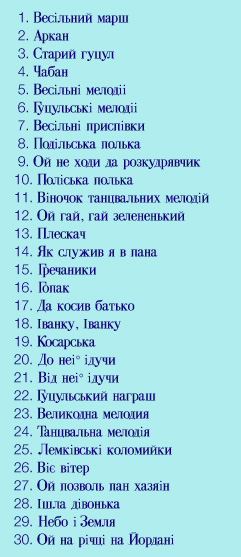 |
The ensemble Khreshchaty Yar was founded in June 1990. All its members have studied either at the conservatory or at the music academy in Kiev and are now musicians by profession.
The name of the ensemble can be explained in two ways:
|
- Yar = "gorge, ravine" and Khreshenye = "baptism". There is a main street in Kiev with this name, and it is said that in 988 AD Prince Volodymyr led his people on this road (at that time it was a country road) to the river Dnepr for baptism.
|
|
- The second explanation derives from an archaic meaning of the two words: Khreshaty = "to be reborn again and again, having reached immortality"; Yar or Yarylo meant "Sun God". Thus, the two words combined stand for the "eternal, immortal or everlasting sun". |
Songs
1. Vesilnyi marsh - Wedding march from the Bukovina region
- Valery Golub: folk fiddle, Vasil Palanjuk: tsymbaly, drum, Volodymyr Budz: sopilka, Yuri Berbenyuk: double bass
|
This march is being played when the wedding guests arrive.
|
2. Arkan - Hutsul dance of the men – Carpathian region
- Valery Golub: folk fiddle, Vasil Palanjuk: tsymbaly, drum, Volodymyr Budz: frilka, Yuri Berbenyuk: double bass
|
Arkan is a ritual dance that goes back to pagan times. Before the hunters set out, they performed this magical dance for a successful hunt.
|
3. Staryj hutsul - the old Hutsul – Carpathian region
- Valery Golub: folk fiddle, Vasil Palanjuk: tsymbaly, drum, Volodymyr Budz: frilka, Yuri Berbenyuk: double bass
|
This dance was performed by old men. The musicians compelled the dancers to dance faster and faster.
|
4. Chaban - Chaban means shepherd – A dance from the Bukovina region
(Bukovina = land of beeches)
- Valery Golub: folk fiddle, Vasil Palanjuk: tsymbaly, drum, Volodymyr Budz: sopilka, Yuri Berbenyuk: double bass |
- (Buk = beeches, the land with the many beeches – the centre is the town Chernivtsi) Bukovina once was part of the Mongolian Principality and the Walachy, later on it was integrated into the Habsburg Monarchy. The Southern part is nowadays called Moldavia, in the West there is situated Maramuresch = Marmatia in today's Romania, bordering in the West Transylvania and in the North the Carpathian region.
|
5. Vesilny melodiy - Hutsul wedding melody from the Carpathian region
- Vasil Palanjuk: tsymbaly (solo)
|
6. Hutsulsky melodiy - Hutsul melody – Carpathian region
- Valery Golub: folk fiddle, Vasil Palanjuk: tsymbaly, drum, Volodymyr Budz: frilka, Yuri Berbenyuk: double bass
|
|
Jaremca is situated in the Hutsul region, South-West of Ivano-Frankovsk at the foot of Mount Hoverla, where the river Prut springs. This is the homeland of the legendary hero "Dovbusa", a kind of Ukrainian Robin Hood. If you want more information on the history of this mountainous population, you should have a look at the legends and stories telling about them. As in older times, mythology is still alive: For example, the fantastic bird-like "Huhuretz" telling fortunes by means of whistling lamenting when you sit at home in front of the open fire. The inhabitants of these wild forests high up in the Carpathian mountains were called "Hutsul". Nowadays, their typical wooden architecture is well known worldwide, especially their churches, which were built in the 17th and 18th centuries in this particular Hutsul style. |
|
"Hutsuls" was the name of a community who lived "high up" in the Transcarpathian mountains and spoke an Ukrainian dialect. After World War I, this region became part of the Austro-Hungarian Empire (after the Constitutional Compromise between Austria and Hungary in 1867) and was divided into a Polish, a Czech and a Romanian dominated affiliation. Those living in the Carpathian foreland of the Ivano-Frankovsk region on both sides of the river Dniestr were called "Boiks". They were also called mountaineers or valley people. They preserved their culture like wedding rites, costumes (shirts, head coverings, long cloaks etc.) and their architecture (two-rooms-houses and churches made from wood). They cultivated land and especially processed corn. Boiks and Hutsuls speaking different Ukrainian dialects (this form of Rusyn-Ukrainia) and belonging to the Greek-Orthodox Church, are actually part of the East-Slavonic population group and of the Romans (also called Ruthenians) who had moved from the Walachy (today's Romania) into the Transcarpathian region in order to establish there a new form of civilization. Later on Germans and also the so-called "Old-Believers" were to follow. |
|
- The race of small horses originating in the Carpathians are called "Hutsulei". They are strong and very good in carrying heavy loads along the difficult mountain paths. A stud farm in Lucina in the today Romanian part of the Bukovina region was already reknown for its breed in the 19th century under Habsburg Monarchy. |
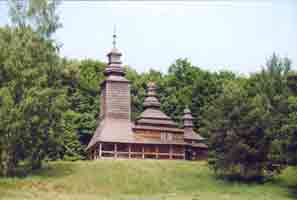 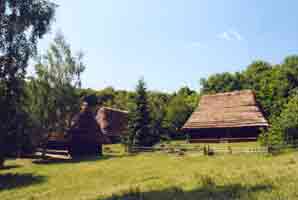
Hutsul architecture (wooden construction)
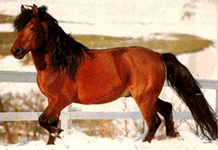
Hutsulei (Small horse - pony)
7. Vesilny pryspivky - Wedding tune from the Kiev region
- Valentyna Bogdanova: voice (solo)
|
This song is sung while the wedding guests are being served at the table (table song).
|
8. Podils'ka polka - dance melody from the Podolia region
- Valery Golub: folk fiddle, Vasil Palanjuk: tsymbaly, Volodymyr Budz: sopilka, Volodymyr Biletsky: buben (frame drum), Yuri Berbenyuk: double bass
|
9. Oie ne khody da rozkudryavchyk - love song from the Cherkasy region
- Valery Golub: folk fiddle, Vasil Palanjuk: tsymbaly, Volodymyr Budz: accordion, Anatoliy Kurylo: voice (soloist), Volodymyr Biletsky: buben (frame drum), Yuri Berbenyuk: double bass, Valentyna Bogdanova: voice (soloist)
|
The young girl loves a Cossack and asks her mother for the permission to marry him.
|
10. Polis'ka polka - dance melody from the Polissya region
- Valery Golub: folk fiddle, Vasil Palanjuk: tsymbaly, Volodymyr Budz: sopilka, Volodymyr Biletsky: buben (frame drum), Yuri Berbenyuk: double bass
|
11. Vinochok tantsyouvalnykh melodiy - dance melody from Central Ukraine
- Valery Golub: folk fiddle, Vasil Palanjuk: tsymbaly, Volodymyr Budz: sopilka, Volodymyr Biletsky: buben (frame drum), Yuri Berbenyuk: double bass
|
12. Oie hay, hay zelenen'ky - love song from Central Ukraine
- Valery Golub: folk fiddle, Vasil Palanjuk: tsymbaly, Volodymyr Budz: sopilka, Volodymyr Biletsky: buben (frame drum), Yuri Berbenyuk: double bass, Valentyna Bogdanova: voice (soloist)
|
A young girl says: "I am pretty and grown-up and want to get married. My husband shall be young and handsome, diligent and willing to work. He shall smother me with caresses.
|
13. Pleskach - folk dance from Central Ukraine
- Valery Golub: folk fiddle, Vasil Palanjuk: tsymbaly, Volodymyr Budz: sopilka, Volodymyr Biletsky: buben (frame drum), Yuri Berbenyuk: double bass
|
The word "pleskach" derives from "pleskaty" and means "to clap ones hands".
|
14. Yak sluzhyv ya v pana - joking song from Central Ukraine
- Valery Golub: folk fiddle, Vasil Palanjuk: tsymbaly, Volodymyr Budz: accordion, Anatoliy Kurylo: voice (soloist), Volodymyr Biletsky: voice, buben (frame drum), Yuri Berbenyuk: double bass, Valentyna Bogdanova: voice (soloist)
|
I was a farmer's servant. For the first year the farmer payed me with a hen, for the second year with a duck, for the third year with a goose, for the fourth year with a turkey, for the fifth year with a mutton, for the sixth year with a calf and for the seventh year with a girl.
|
15. Hrechanyky - folk dance from Central Ukraine
- Valery Golub: folk fiddle, Vasil Palanjuk: tsymbaly, Volodymyr Budz: sopilka, Volodymyr Biletsky: buben (frame drum), Yuri Berbenyuk: double bass
|
Hrechanyky is the name of a small pie made of buckwheat.
|
16. Hopak - folk dance from Central Ukraine
- Valery Golub: folk fiddle, Vasil Palanjuk: tsymbaly, Volodymyr Budz: sopilka, Volodymyr Biletsky: buben (frame drum), Anatoliy Kurylo: drums, Yuri Berbenyuk: double bass
|
An improvised men's dance and also a contest for the single dancers. Who is able to combine the most varied figures (knee bend, jump, rotation, etc.; this dance was also performed with the sabre).
|
17. Da kosyv bat'ko - table song from the Poltava region
- Valentyna Bogdanova: voice (soloist), Anatoliy Kurylo, Volodymyr Biletsky, Ivan Volynets, Volodymyr Budz: voice
- Accompaniment: Vasil Palanjuk (spoons, bottles and washboard)
|
A girl loves a young man and says, "Come to see me on Sunday, and I will give you a nice embroidered shirt. Come to see me on Monday, and we will go together to look for the periwinkle (vinca minor, evergreen plant). Come to see me on Tuesday, and we will bind the sheaf.
|
- When a girl gives a shirt to a man, she agrees to marry him. The periwinkle is used to embellish the wedding dress.
|
18. Ivanku, ivanku - love song from Western Ukraine (Carpathian)
- Valery Golub: folk fiddle, Vasil Palanjuk: tsymbaly, drum, Volodymyr Budz: sopilka, Anatoliy Kurylo: voice (soloist), Yuri Berbenyuk: double bass, Valentyna Bogdanova: voice (soloist)
|
A girls is says to a man, "Come to see me today. I'll give you a sign, when my parents are away."
|
19. Kosarska - from the Carpathian region
- Volodymyr Budz: frilka (solo)
|
"Kosarska" means hay melody. It is a melody sung during hay making.
|
20. Do ney iduchy - from the Carpathian region
- Volodymyr Budz: frilka (solo)
|
"Do nei iduchy" means "going or walking to her".
|
21. Vid ney iduchy - from the Carpathian region
- Volodymyr Budz: frilka (solo)
|
"Vid nei iduchy" means "going or walking away from her".
|
22. Hutsuls'kiy nahrash (drymba) - from the Carpathian region
- Vasil Palanjuk: drymba - jew's harp (solo)
|
23. Velykodna melodiya - Easter melody from the Carpathian region
- Vasil Palanjuk: tylynka (solo)
|
24. Tantsyouvalna melodiya - dance melody from Central Ukraine
- Valery Golub: folk fiddle, Vasil Palanjuk: tsymbaly, Volodymyr Budz: sosulya (solo), Yuri Berbenyuk: double bass
|
25. Lemkivsky kolomiyky - dance melody from the Lemko region (Carpathian)
- Valery Golub: folk fiddle, Vasil Palanjuk: dvodenzivka (solo), drum, Volodymyr Budz: accordion, Yuri Berbenyuk: double bass
|
|
- The region in Southeastern Poland, where the Rusyn (Ruthenians) lived, was known as Lemko (today: Beskid Niski region). This mountain population, also called Rusyn and Ruthenians, speaks an Ukrainian dialect and belongs to the Greek-Orthodox Church, like the Boiks and Hutsuls. In their liturgical works they used the Cyrillic alphabet. After World War II they were resettled. Some of them returned to their old homeland. This region belonged to the Polish Kingdom of Galicia until the mid-14th century. From 1340 until 1772 it was completely annexed to Poland. After that until 1918, it belonged to Austria (hence the denomination "Ruthenians" for "Ukrainian") and then to the Austro-Hungarian Empire. Today it is again part of Poland.
*Ruthenians: a branch of East-Slavonic and Romanian people who migrated from the Walachy into the Carpathian region and spoke an Ukrainian dialect.
|
|
- Kolomyiky (kolomejka) means melody (also couplets* - wild dance of the men).
The name is deduced from the former city of Kolomya in the Ivano-Frankovsk region near Chernivtsi (Bukovina region). In this city, who formerly belonged to the Habsburg Monarchy, Ukrainians, Jews, Poles, and Germans were peacefully living together. There was spoken an Ukrainian dialect with loanwords from the Polish and German language.
|
|
*Couplet singing: historical songs, psalms (performed with an instrumental ensemble and the kobza (luth-like instrument)) or lyric songs with a strophic structure, kolyadky (praise songs), marches and other ritual folk-tunes in the form of the singing-dancing. |
|
26. Viye viter - ballad from Central Ukraine
- Volodymyr Biletsky (solo), Ivan Volynets, Anatoliy Kurylo, Volodymyr Budz: voice
Guest: Ivan Tkalenko: bandura
|
A Cossack addresses the wind, "Tell me, wind, where is the Cossack's fate and his hope, where is the Cossack's glory and his freedom?"
|
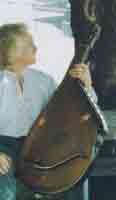 |
- Bandura (type of psaltery)
The bandura is a traditional plucked string instrument that combines the acoustic principles of both the lute and the harp. It is a uniquely Ukrainian instrument with a sound that is empathic and gentle, resembling that of a harpsichord, but with a wider range of dynamics and tonal control. The Ukrainian bandura is thought to have evolved from a line of lute-like instruments, such as its predecessor, the kobza.
The main distinguishing characteristics are:
- 1) the absence of frets, which means that each string can sound only one note, as in a harp, and
- 2) the presence of treble strings streched over the soundboard, off center from the bass strings that run along the neck. The result is an asymmetric body. The once homemade folk instruments have variations in shape.
From the 15th to the 18th century, the bandura was played by the kobzari (a kobzar is a wandering minstrel, usually blind and sometimes led by a child) and kozaks (cossacks, or free warriors). In the villages and towns, the kobzari sang epic songs (dumy, singular = duma) about the people's exploits and relations with the Turks and the Tatars, and later about their troubles with the Polish regime. The use and popularity of the bandura coincided with the rise of Ukrainian patriotism and nationalism and the subsequent flourishing of the various expressions of art.
Today there are three major types of banduras played in concert:
- the classical or folk bandura, tuned diatonically with 20-24 strings and wooden pegs;
- the Kharkiv bandura, developed by Hnat Khotkevych at the beginning of the 20th century and introduced as an instrument taught at the Kharkiv Conservatory. At first it was tuned diatonically and then developed into a fully chromatic instrument with 34 to 65 strings and three orchestral sizes: piccolo, prima, and bass;
- the Kyiv bandura, developed in the 20th century and based on the classical instrument but with 55 to 64 strings tuned chromatically and a universal mechanism like that of a harp. The Kyiv bandura is also made in several sizes and types.
|
|
|
Koladka – praise song: Before the conversion to Christianity, this term was used for praise songs of the Kolada festival. The praise is for a man, a woman, a girl or children in general (see example 27 and 28). Since the conversion to Christianity in the 9th century, these songs have Christian content (see example 29 and 30).
|
|
The original pagan concepts of various gods and natural forces and the relative practices and rituals like those celebrated on the occasion of summer solstice and mid-winter or in spring have been transformed into Christian calendar festivals. In this way, the mid-winter festival of Kolyada was merged with Christmas and Epiphany; the festival of spring with Easter; and the harvest and summer solstice festival of Kupalo with the celebration of Saint John the Baptist.
|
27. Oie pozvol pan khazyan - praise song from Central Ukraine (koladka)
- Anatoliy Kurylo (solo), Valentyna Bogdanova, Volodymyr Biletsky, Ivan Volynets, Volodymyr Budz: voice
This is a praise song for a man.
|
28. Ishla divon'ka - praise song from Central Ukraine (koladka)
- Valentyna Bogdanova (solo), Anatoliy Kurylo, Volodymyr Biletsky, Ivan Volynets, Volodymyr Budz: voice
- Volodymyr Budz: little bell
|
A young girl met three hay-makers and said, „You, my dear hay-makers, cut the grass and make hay for me. The first will get from me silk-grass, the second a golden ring, and the third will get me as his bride."
|
29. Nebo y zemlya - Christian song from Central Ukraine (koladka)
- Valentyna Bogdanova , Anatoliy Kurylo: (solo), Volodymyr Biletsky, Ivan Volynets, Volodymyr Budz: voice
|
Heaven and Earth celebrate today the birth of Christ.
|
30. Oie na richtsy na Yordany - Christian song from the Cherkasy region (koladka)
- Valentyna Bogdanova, Anatoliy Kurylo: (solo), Volodymyr Biletsky, Ivan Volynets, Volodymyr Budz: voice
|
The mother gave birth to her son at the river Jordan. Her son says to her, "Don't be frightened, you will be called mother of the whole world".
|
- more information Traditional Music and Instruments from the Ukraine
The Ukraine
The present-day Ukraine is a state in the size of France with more than 50 million inhabitants. Wide parts belong to the Eastern European lowland. Big rivers like the Volga, the Don, the Dnepr, and the Dniester flow through this land, and some of them into the Black Sea. Quite early, they became very important trade routes to the North and to Central Europe. In the Ukraine, there are no natural borders except for the Carpathian mountains in the West and the Prypjat marshland in the Northwest, which have been areas of both frequent military conflict and cultural transmission. The word Ukraine means border area, and as history shows, the area came under the influence of different cultural influences and reigns. On the edge of the steppes north of the Black Sea, the borders between the sedentary societies of the Christian Slavs and the nomadic tribes of Islamic Tartars were blurred. Later, North-Western and Central Ukraine became an arena of expansion for a new power that had arisen in the 13th century, the Grand-Duchy of Lithuania. Then the greater part of the Ukrainian territories was detached from Lithuania and annexed directly to the Kingdom of Poland. Then followed the Russian Empire, the Habsburg Empire and, in the 20th Century, again Poland and the Soviet Union.
The Ukraine was only autonomous during the Kievan Empire (Kievan Rus) from the 10th to the 13th century, then as the principality Galicia-Volhynia in the 13th and the 14th centuries, as the Hetmanate (hetman or ataman = commander in chief) of the Dnepr Cossacks in the 17th century and in 1918, and finally from 1918 to 1920 as the Ukrainian People's Republic.
- map sketch Historical map of the Ukraine
The Carpathian mountains
The Ukrainian Carpathians are an immense, densely forested mountain range that extends from North-West to South-West. The climate here is warm and humid. The Carpathians, the Transcarpathians (behind der Carpathians) and the Carpathian Foreland today constitute a geographic part of the Western Ukraine and border Slovakia, Hungary and, in the South, Romania. The highest mountain in this region with 2'061 meters above sea level is Mount Hoverla. A mixture of various languages and cultures has bestowed this region with an interesting and probably unique atmosphere, the socalled Rusyn-Folk Art with their traditional music and dance, the colouring of Easter eggs, naive painting style, icon painting and wooden architecture (timber-construction churches).
Apart from the Slavic tribes, the so-called White Croatians from Eastern Poland, the Southwest of Belarus and the Northwestern Ukraine, who had migrated thereto in the times bevor Chirst (during the sixth and seventh centuries AD), later on also Hungarians, Germans, Austrians, Romanians, and Jena-people from Romania settled there. The lived together peacefully in this hilly landscape and primarily were occupied with sheep breeding, agriculture, and forestry. In the course of its development, however, this Carpathian region has been part of many different realms, such as the Kingdom of Hungary from the 13th century on. In today's Bukovina region there lived mainly Ukrainians in the North and Romanians in the South. Between the 14th and the 16th century, the region experienced mass migrations across the Carpathians up to the planes of today's Western Ukraine. The tribes living in this Carpathian region were called "Ruthenians" which goes back to an Austrian expression for Slovaks, Poles, and the original Ukrainians who had spoken a homogeneous dialect, very similar to the Ukrainian language of today. They called themselves Rusyn. The region Bukovina (Land of the Beeches) was under the influence of the Principality of Moldavia, and in the year 1514 it was conquered by the Turks. In the middle of the 19th century the Bukovina Jews turned the city of Chernivtsi into an economic and cultural centre. The Romans, however, conquered the region in 1918 and, in this way, brought to an end a rather long Habsburg supremacy. Only in 1944 the region of the Carpathians was completey incorporated into the Ukraine.
- There is more information about the history of the Ukraine and the Cossacks in the album Kreshchaty Yar - Vol. I, FM 50031
Language and Religion
The Ukrainian language belongs, like Russian and Belo Russian, to the family of the East Slavic languages. Written documents can only be traced back to the time when Christianity had been adopted and Kiev had become the first Christian centre in the Eastern Slavic area in 998 AD. The oldest documents are transcriptions of church texts that, in the 9th century, the Slavic apostles Kyrill and Method had transcribed into the South-Slavic dialect of the Thessalonica area. For this purpose they created an alphabet similar to Greek and called it Kyrilliza. These texts, also known as old Bulgarian or old Slavonic texts, are the basis of the current Church language of all Orthodox Slavs, Bulgarians, Serbs, Russians, Ukrainians etc.. Due to the political separation from Northern Russia and the affiliation to the Lithuanian Grand-Duchy and later to the Kingdom of Poland, Ukrainian appears as a language of its own in the 14th century.
Carpathians
The dialect spoken by the people living in the Carpathian mountains belongs to the family of Eastern Slavonic languages and is mainly like Ukrainian. This area has been influenced linguistically very much by the neighbouring Poles, Slovaks, Hungarians, and Romanians.
The lithurgical language put its stamp on this East-West relation, too, and so the Cyrillic alphabet was introduced. The orientation was mainly towards the East Slavic Church from which most rituals have been adopted. But apparently, there are also influences from the Roman Catholic Church because of the long affiliation to the Hungarian Kingdom and later to the Polish-Lithuanian and then the Austro-Hungarian Empire. A further important role played the Eastern Jewish tradition, and there was also some influence by the immigrated Protestants from Germany.
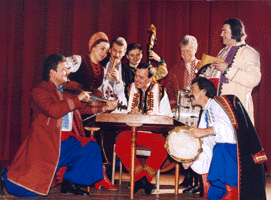 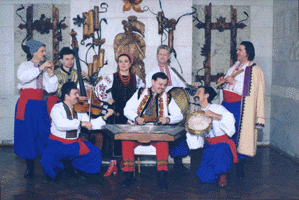
Ensemble Khreshchaty Yar
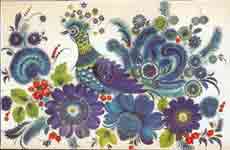 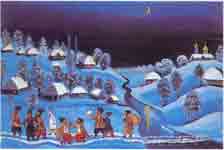
left: Embroidery pattern from the Ukraine with bird motif - right: "Stchedry Wetschir" Christmas evening by Mychajlo Onatsko
- You can find more information about traditional songs of the Cossacks in the albums with the Ensemble Pesnokhorki from Barnaul, Siberia / Russia: FM 50017 and FM 50019.
English translation: Silvia Delorenzi-SchenkeL
Many thanks for helping to the good souls Regina Hunziker and Zimi
|
